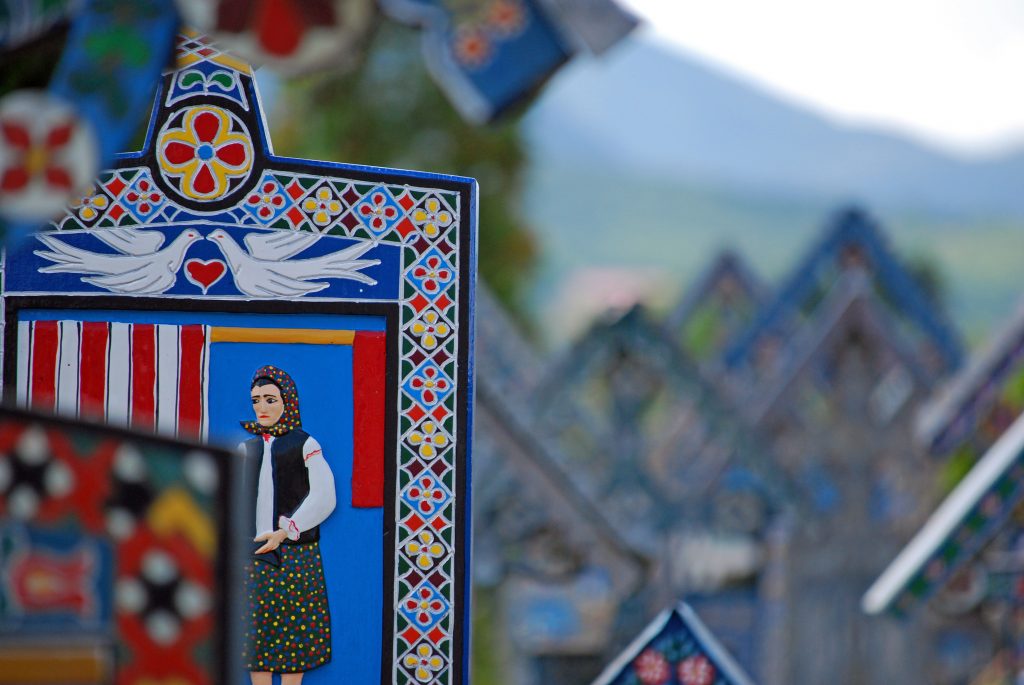HAPPILY CEMETERY – TOURIST ATTRACTION IN THE NORTH OF ROMANIA

What was your first thought of a cemetery? Sadness, pain? Can you imagine that there is a cemetery that is a complete antonym of the prototype cemetery as a place where we always go sad. Perhaps the strangest and most interesting attraction in the north of Romania, in the Maramures region – “Merry Cemetery”, in the village of Sep’nca, known for its colorful tombstones (usually bright blue), which have “naive and funny pictures” of local artists, poetic articles about the deceased. Over time, this place became an open-air museum and one of the main tourist attractions of Romania.
It is known for its cheerful tombstones, which with pictures and words represent the life of the person below it. The founder of the cemetery is considered to be Stan loan Patras, a local artist, who sculpted the first tombstone in 1935. An unusual feature of this cemetery stems from the widespread belief, which is culturally represented within European society, that death is a solemn occasion because it represents a moment filled with pleasure and hope for a better life.
Some of the stories on the tombstones are extremely witty, others are capricious, while some are tragic because they represent lives interrupted by accidents or illness.
Pop Dumitru has been in charge of creating these, apparently, small masterpieces for thirty years. When a person dies, the family of the deceased asks the priest to make a cross, which he carves by hand, he decides which pictures and verses will represent the life of the deceased. The purpose of the pictures and the poem is not to ridicule the grave – on the contrary. Although some of them are a bit indiscreet because they talk openly about adultery, love of alcohol and intolerance towards some family members. You would think that relatives will be offended when they see them, but no, Pop Dumitru says: “The real life of a person is on the plates. If he liked to drink, we will say that; if he liked to work, that’s what we’re going to paint. Everything that is found on the monuments is true, there are no secrets in a small town. ”

Of course, no cross is complete without a short poem, and that is perhaps the most interesting. On each monument, there is a poem, between 7 and 17 verses long, which is engraved under the picture, a real poetic epitaph, and they are all in the local Maramures dialect. They are always extremely touching, honest and are written in the first person singular, as if the deceased is addressing the reader. The style is usually lyrical and has a touch of sadness, but satirical or extremely ironic chants are also common. Each poem contains the name of the deceased and summarizes the most essential aspects of his life, personality or habits. Sometimes, the songs even talk about things that happened after the death of the person in question, or even at the funeral, or describe how the death occurred. If, on the other hand, bad habits are sung about, they are presented in a humorous way, but with a deep moralizing tone. There are also a lot of funny drawings and funny inscriptions: there are truck drivers, drunkards with bottles, bus drivers next to their vehicles and many other crazy things, all drawn by the half-skilled hand of uneducated artists, respecting the proportions “as much as possible”.

The verses on the tombstones are written in the first person and as you read them, you feel as if you are talking to a person who is buried there. What you feel as you read them is that you have, at least a little, met the deceased. One of the plates reads:
“I rest here,
Stefan is my name.
I drank a lot and that’s why I’m still thirsty.
Therefore you, who visit my resting place,
Leave some wine behind. ”
Even if you can’t read the verses in the original Romanian, you can always enjoy the stories that the drawings offer. Some of them have more than one image and thus illustrate multiple events in a person’s life. One grave has three tablets, on the first are a man and a girl, embracing, in love; on the other a man sits at a table with a bottle in his hand, while a woman sits alone in a corner; on the third board, the man looks over his shoulder at his wife, who is in the next room with the other man.

The merry cemetery contains about 800 graves, although it is an extremely popular place, it is still not completely filled, and priest Dumitru will rest here, who is already training several apprentices who will one day succeed him. “They can’t be anyone,” he said. “They have three jobs to do. They must also be sculptors, painters and poets. ”
lon Stan Patras, the creator of this cemetery, rests there. His tombstone says that he created merry plaques because he loved people and wanted people to visit him, even after death. Considering that the Merry Cemetery is one of the most visited destinations in Romania, we can say that it succeeded in its idea. This place exudes the belief that death is just another great adventure in the next life, another beginning, and every beginning deserves a happy celebration.

Here is another fun song in which many men will find themselves:
Under this heavy cross
My poor mother-in-law is lying.
That she lived for another three days
I would lie here now and you would read about me.
You, passerby
Try not to wake her,
Because if he comes home
It will bite my head off.
But I will continue my life
As if she would never return home.
Stay here
My dear mother-in-law!



